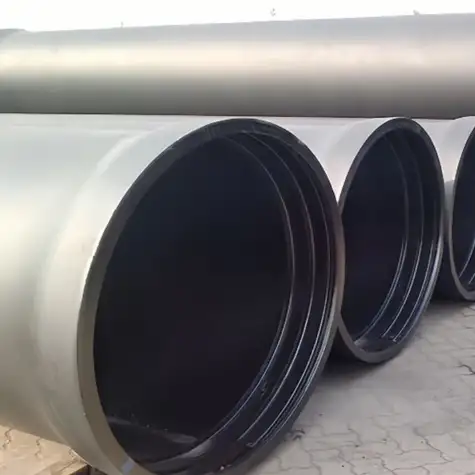I’ve spent years working with water infrastructure. In my experience, choosing the right pipe means balancing resilience, compliance, and cost. Electrosteel’s ductile iron pipe (DIP) stands out—strong mechanically, corrosion-resistant, and globally accepted. When I first assessed Electrosteel’s products, I was particularly struck by their robustness under pressure and quality control processes.
1. Manufacturing & Material Characteristics
Electrosteel DIP is crafted by adding magnesium to molten iron. This process yields a ductile iron featuring a unique microstructure with spheroidal graphite. The result is a pipe with:
-
High tensile strength (~60,000 psi minimum)
-
Impressive impact resistance, far superior to traditional grey cast iron
-
Long-term durability, often exceeding a century in service
Electrosteel strictly uses virgin iron ore—not recycled metal. This ensures consistency and quality across batches.
2. Sizes & Pressure Classes
Electrosteel DIP is available in sizes from 3″ to 36″ (80 mm to 900 mm). Pressure classes range widely under ANSI/AWWA C150 standards. Common working pressures include:
-
150 psi (Class 150)
-
200 psi (Class 200)
-
250 psi (Class 250)
-
300 psi (Class 300)
-
350 psi (Class 350)
Each pipe wall thickness is calculated per ANSI/AWWA C150, which includes internal working pressure plus a 100 psi surge allowance and a 2.0 safety factor.
A simplified size–thickness table (excerpt below):
I frequently advise contractors to choose size and class based on hydraulic demands and soil conditions.
3. Coatings & Linings
Electrosteel applies multiple protective layers:
-
200 g/m² zinc metallization (base)
-
3 mil polymer topcoat, color-coded (blue for potable water, green for sewer)
-
Double cement lining per ANSI/AWWA C104
-
Optional fusion-bonded epoxy coatings for aggressive environments
These surface treatments improve corrosion resistance and reduce life-cycle maintenance.
4. Standards & Certifications
Electrosteel DIP complies with major global standards:
-
ANSI/AWWA C150/C151/C111/C600 (USA)
-
BS EN 545 / 598 (Europe)
-
ANSI B16.1 flanges (USA)
-
Key accreditations from NSF, UL, FM, ACS, DWI, WRAS, ISO 9001, ISO 14001, SA 8000
These assure regulators and engineers of consistent quality and safety.
5. Supplier Highlight: Luokaiwei
As a trusted channel partner, Luokaiwei stands out. They offer:
-
Full DIP ranges
-
On-site technical support during installation
-
Customized catalogue and pricing quotes
With strong logistics and stock in China, they can quickly supply project sites across world.
6. Price & Catalogue Overview
Electrosteel DIP is priced competitively, and Luokaiwei provides tailored pricing. Estimated delivered cost for a 12″ Class 250 pipe runs about $60–$80/ft (USD), depending on order size. Discounts apply for bulk orders. Their catalogue includes:
-
Size and pressure-class options
-
Technical datasheets
-
Coating and joint details
-
Installation guides and dimensional tables
I recommend catalogues that mirror ANSI/AWWA tables for easy reference and quick spec checks.
7. Case Study: Water Utility Deployment
Background:
A Southern California water district faced frequent pipe leaks and corrosion issues with aging PVC mains. They aimed to upgrade to stronger infrastructure and selected Electrosteel DIP via Luokaiwei.
Project Details:
-
Scope: 4,000 ft of 24″ Class 300 DIP
-
Coatings: Zinc + polymer topcoat (blue), cement-lined
-
Joints: PushTite® flexible gaskets
-
Duration: 9 months planning, 6 weeks installation
Outcomes:
-
Leak incidents dropped from 45/year to 4/year
-
Estimated water saved: ~10 million gallons/year
-
Life expectancy projected at >100 years
This case highlights Electrosteel DIP’s impact on reliability and sustainability. The district noted, “installation was smooth, and we’ve already saved significantly on maintenance.”
8. Comparative Table
| Feature | Electrosteel DIP | PVC Pipe | Grey Cast Iron DIP |
|---|---|---|---|
| Tensile Strength | ~60,000 psi | ~7,000 psi | ~30,000 psi (brittle) |
| Joint Type | Push-on or flanged | Solvent-weld or gasket | Flanged/butt-weld |
| Corrosion Protection | Zinc + polymer + cement | Generally none | Bitumen coatings |
| Life Expectancy | > 100 years | 50–80 years | 50–70 years |
| Leak Resistance | High | Moderate | Moderate |
| Price per ft (12″) | $60–$80 | $30–$50 | $50–$70 |
| Installation Notes | Heavier; skilled labor | Lighter; easy handling | Heavy; prone to breakage |
This table helps engineers evaluate suitability based on project demands.
9. Advantages & Industry Idioms
-
Robust as a battleship: DIP withstands high pressure and traffic loading
-
PushTite® joints: Quick-install push-on gaskets save time
-
Tombstone warranty: Designed to outlast its installation site
-
Blue-water certainty: Topcoats identify potable lines at a glance
-
Bite the bullet: Upfront investment avoids future headaches
10. Common FAQs
1. What is a ductile iron pipe vs. cast iron pipe?
Ductile iron uses magnesium in its alloy to produce a flexible microstructure with spheroidal graphite, offering much greater tensile strength (~60 ksi) and ductility than grey cast iron (~30 ksi brittle).
2. Why include 100 psi surge allowance?
Water systems often experience pressure spikes (e.g., valve closure events). Standards like ANSI/AWWA C150 require a 100 psi allowance added to working pressure to ensure the pipe walls can safely handle pressure transients.
3. Can DIP be buried in aggressive soils?
Yes. Electrosteel DIP offers coatings and lining options (epoxy, cement) that make it suitable for soils with pH extremes or chemical content. For highly corrosive environments, add epoxy tops or trench wrap.
4. What joint types are available?
Electrosteel provides both flexible PushTite® spigot–socket joints and flanged joints compliant with AWWA or ANSI B16.1 standards. Flex joints help absorb ground movement; flanges suit above-ground piping.
5. How does DIP help water conservation?
With minimal leakage and proven endurance, DIP reduces water loss significantly. In the case study above, a district saved ~10 million gallons annually after replacing PVC mains with DIP.

